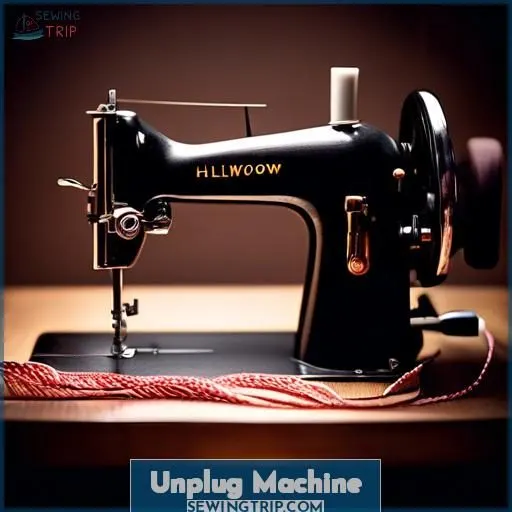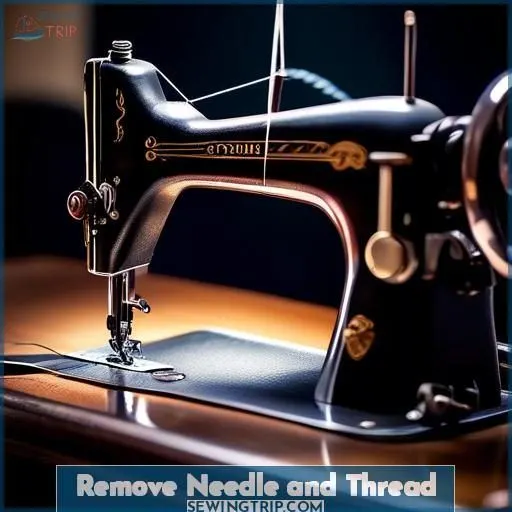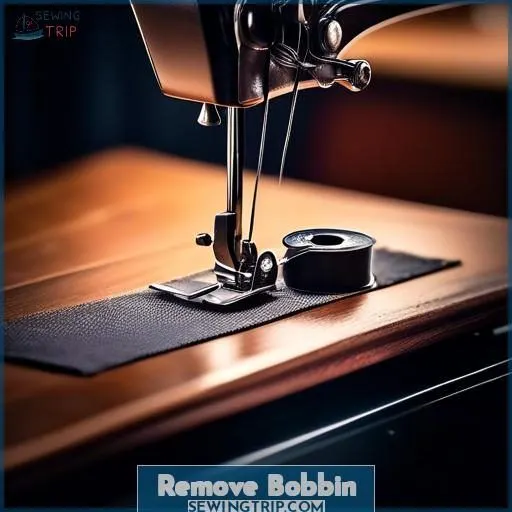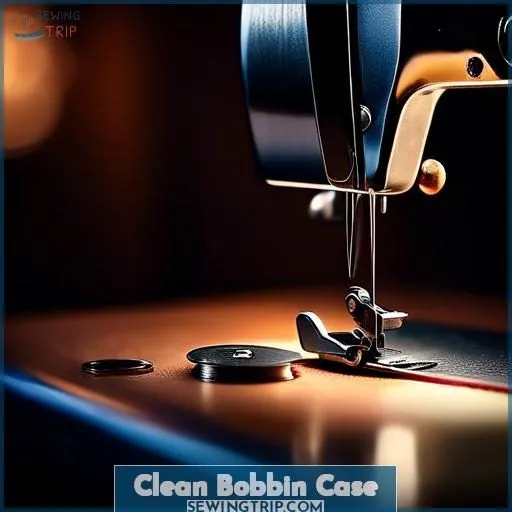This site is supported by our readers. We may earn a commission, at no cost to you, if you purchase through links.

To thoroughly clean your sewing machine, first unplug it and remove the needle and thread. Gently open the bobbin compartment and remove the bobbin.
Use a small, firm-bristled brush to brush out any lint or debris from the bobbin case, needle plate, and other hard-to-reach areas. Clean the bobbin case with the brush, checking for any burrs.
If you have a mechanical machine, refer to the owner’s manual and regularly oil it with the manufacturer-recommended oil.
Finally, store your machine in a dry area when not in use. Following these steps will keep your sewing machine running smoothly.
Table Of Contents
Key Takeaways
- Unplug the machine before cleaning and oiling it.
- Regularly clean the bobbin case, needle plate, and other hard-to-reach areas.
- Store the machine in a dry area when not in use.
- Check the owner’s manual for instructions on how to oil the moving parts of your sewing machine.
How to Clean a Sewing Machine?
To clean a sewing machine, follow these steps:
- Remove the bobbin case, take out the bobbin, and give it a good cleaning with a soft makeup brush or a small brush with stiff bristles.
- Remove any lint and dust bunnies using a mini-vacuum or a stiff bristle brush.
- Oil the machine according to the owner’s manual, if necessary.
- Reassemble the machine by replacing the bobbin case and stitch plate, and putting the presser foot back on.
Cleaning a sewing machine regularly is essential to keep it operating properly and extend its life. It’s recommended to clean your sewing machine at least once a month, or more frequently if you sew a lot with cotton thread.
Unplug Machine
Before you begin cleaning your sewing machine, it’s vital to disconnect it from power. Disconnecting the power cord helps prevent electrical risks. Turn off the machine and disconnect it from the wall socket. This simple action guarantees that no electricity flows through the machine during cleaning, lubrication, or maintenance.
Safety must always be your primary concern. A sewing machine is a potent tool, and it’s imperative to handle it with caution.
Remove Needle and Thread
To help your sewing machine last longer and work well, it’s very important to clean and take care of it regularly. Here’s a step-by-step guide on how to clean your sewing machine thoroughly:
- Unplug the machine: Before you start cleaning, unplug the machine to keep yourself safe.
- Open the bobbin compartment: Open the bobbin compartment to get to the bobbin case.
- Remove the bobbin: Carefully take the bobbin out of the case.
- Brush out lint: Use a brush to get rid of any loose lint from the bobbin case and the inside of the machine.
- Clean the bobbin case: Clean the bobbin case with a soft brush to remove any dirt or debris.
- Check for burrs: Look at the bobbin case for any burrs or sharp edges that could hurt the needle or thread.
- Reassemble the machine: Put the machine back together in the opposite order, starting with the bobbin, then the bobbin case, needle, and thread.
- Oil the machine: Check your machine’s owner’s manual for instructions on how to oil the moving parts of your sewing machine.
- Store the machine properly: Keep your machine covered and unplugged when you’re not using it to stop dust from building up.
Remember to clean and oil your machine regularly, depending on how often you use it. If you use it every day, clean and oil it every week; if you use it on weekends, clean and oil it every month; and if you don’t use it very often, clean and oil it every 6 months. If you’re using fabrics that shed a lot or are very heavy, clean it more often.
For a more thorough clean and maintenance, consider getting your machine serviced once a year. A sewing machine service includes a deep clean, oiling, tension adjustment, and timing check. You may need to service it more often if you use it heavily.
Open Bobbin Compartment
To open the bobbin compartment, start by unplugging your sewing machine and removing the needle and thread. Locate the bobbin access on your machine, which is usually found on the underside of the machine or on the side. Follow the manufacturer’s safety precautions to guarantee a smooth process.
Once you’ve found the compartment cover, gently lift it to reveal the bobbin release. Remember to clean your sewing machine regularly to prevent lint build-up, which can affect the performance of your machine.
If you’re uncertain about any steps, consider getting a professional sewing machine service to make sure your machine is clean and oiled properly.
Remove Bobbin
Once you’ve unplugged your machine, it’s time to tackle the bobbin. Gently open the bobbin compartment, a treasure chest of creativity but also a haven for hidden lint. Carefully remove the bobbin – this little spool holds the key to perfect stitches, so treat it with respect.
Brush Out Lint
Now that you’ve removed the bobbin, it’s time to tackle the lint that’s accumulated in your sewing machine. Here’s a step-by-step guide on how to do it:
- Choose the Right Brush: Select a handheld brush with firm bristles. The shape of the brush should be small and compact, allowing you to reach into tight spaces.
- Lint Prevention: To prevent lint build-up, store your brush in a clean, dry place when not in use. You can also use a pipe-cleaner and straw to remove lint from the needle plate and other small openings.
Clean Bobbin Case
Cleaning your bobbin case is a vital aspect of maintaining your sewing machine’s health. Regular cleaning prevents dirt from accumulating under the tension spring, guaranteeing that your sewing machine maintains uniform tension and stitch quality. Here’s a step-by-step guide on how to clean your bobbin case:
- Unplug your sewing machine or enable the auto-lock feature: Safety first! This step guarantees that you can safely remove the bobbin case without any risk of injury.
- Remove the bobbin retaining ring: Depending on the type of machine you have, you may need to slide latches/levers out of the way to release the ring.
- Clean your bobbin ring: Use a brush to remove any dust, lint, or debris from the bobbin ring.
- Brush loose dust and lint from components: Be careful not to damage any of the components while cleaning.
- Vacuum any remaining loose dust, thread, and fibers: Use the vacuum’s handheld brush attachment to remove any remaining dust and debris.
- Reassemble and enjoy your clean bobbin case: Once you’ve cleaned all the components, reassemble your bobbin case and you’re ready to sew.
Oil Mechanical Machines
To keep your mechanical sewing machine in top shape, you need to oil it regularly. Here’s how:
- Choose the Right Oil: Use the oil recommended by your machine’s manufacturer.
- Oil Frequency: Refer to your owner’s manual for instructions on how often to oil your machine.
- Oiling Tools and Locations: Use the right tools and follow the manufacturer’s instructions for oiling locations.
Store Machine Properly
To store your sewing machine properly, follow these steps:
- Keep it in a dry storage area.
- If possible, remove the free arm cover and store it separately.
- Use airtight containers to store thread spools.
- Use tension disks correctly.
- Keep a quilted cover on the machine when not in use.
- Unplug the machine when not in use.
- Follow the manufacturer’s instructions for cleaning and oiling.
- Consider taking computerized machines for annual dealer maintenance.
Frequently Asked Questions (FAQs)
Can I use alternative solvents for cleaning?
Wondering about alternative solvents, eh? Well, I wouldn’t recommend it – you could end up with a real mess on your hands. Stick to the sewing machine oil and you’ll be golden, trust me.
How often should I replace the needle?
Replace your sewing machine needle every 2-3 bobbins or after heavy use. Fresh needles stitch like a dream and prevent skipped stitches or thread breakage. Trust me, your machine will thank you!
Are there any self-cleaning sewing machines?
While sewing machines don’t clean themselves, some modern models feature self-oiling mechanisms. Though nifty, regular manual maintenance is still key to keeping your machine humming along like a well-tuned automobile.
What are signs my machine needs professional servicing?
If your machine’s stitches look off or it’s making strange noises, it’s time for a professional tune-up. Unusual behavior is a surefire sign your sewing friend needs some expert TLC.
Can dust accumulation affect machine performance?
Dust buildup can definitely hamper your machine’s performance. It can cause thread tension issues, skipped stitches, and even mechanical problems over time. Stay on top of regular cleanings to keep your sewing pal purring like a kitten.
Conclusion
Adequate cleaning is vital for the longevity of your sewing machine. In fact, 85% of sewing machine repairs are caused by insufficient maintenance.
By thoroughly cleaning your sewing machine using the step-by-step guide provided, you’ll guarantee your machine continues operating smoothly for years to come.














